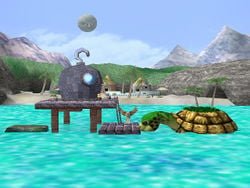Great Bay
| Great Bay | |
|---|---|
 File:Triforce Icon.gif | |
| Universe | The Legend of Zelda |
| Appears in | SSBM |
| Availability | Starter |
Great Bay is a level in Super Smash Bros. Melee that could be considered Young Link's stage (it is where you fight him when you attempt to unlock him.) Announced at E3 2001, This level is quite fair, although the advantage goes to the large character instead of the small one. It is best to be large because of the setup of the level itself: The more space one can control on the small platforms on the side, the less vulnerable they are to any approach on that area. Staying to the right side of the stage also provides advantage due to the mismatched length of the stage; the area with the turtle has a very long distance to the wall unlike the other.
The water has no effect on characters in this stage. The left platform fits only about two people, and this is still a pretty small area for two people to be dueling. The bottom right platform is equivalent in size and shape. Above and between the two small side platforms, there is a long platform that is the main fighting area. This platform is flat without any obstacles,and provides an easy KO oppurtunity; by having your back face the bottom of the main platform, throwing an opponent behind you will result in them hitting the bottom of the platform and tumbling into the water, taking down the unwary opponent at even low percentages.The main platform can fit four fighters, but only about three comfortably. Sporadically, a large, green turtle will appear in either of two orientations to the right of the stage. After about half a minute, the turtle will sink back into the ocean, killing any players who choose to remain on it. On its shell, it has green grass that provides normal movement friction for characters, but any spots of the turtle not covered by grass will work like a slick surface (i.e. ice or oil). Additionally, the turtle has trees on its shell that players can stand on.
Tingle, from The Legend of Zelda: Majora's Mask game also appears on this stage. Tingle floats around on a red balloon on the right side of the stage, directly above the right-bottom platform. It is possible to pop his balloon, causing him to flail his arms and legs and fall to the ground or water below. While he is flailing his arms and legs, he can deal 1-2% damage with negligible knockback.
In All-Star mode, this stage is played on when you face Link and any of his teammates.
Origin
This stage is from The Legend of Zelda: Majora's Mask. It takes place on the Great Bay in Termina. In MM, one can go to the building with a hook on it. In Melee, the player battles on the same platform as the building is on. In MM, one has to get on a giant turtle's back. In Melee, one can battle on the turtle's back but, the turtle is scaled down. In MM, the turtle doesn't go to the hook building. In MM, Tingle is hanging from a balloon and, one can pop the balloon and he blows up another balloon. In Melee, Tingle does the same thing. The background in Melee is very accurate to the shore in MM. In MM, the moon gets closer to the bay. There are these giants in MM that stop the moon. In Melee, the moon looks similar to the one in MM. The giants stop the moon but, they push it back to it's original spot.
There are two songs for this stage. One song is the original version of Sarah's Song from The Legend of Zelda: Ocarina of Time. The second one is an orchestrated version of the main theme from The Legend of Zelda.
Trivia
- In the game The Legend of Zelda : Majora's Mask, this area has a different name.
- Also, in this game, it faced the direction where Clock Town is. In Melee, we can see that the stage turns its back to Clock Town because the moon is falling just in the background.
- Additionally, in the original game, the moon wasn't be pushed back in the skies. It was just destroyed because of the death of Majora. In SSBM, this change allows the stage to return to its "normal position", although it is not a moving stage.
| Stages in Super Smash Bros. Melee | |
|---|---|
| Starter stages | Brinstar · Corneria · Fountain of Dreams · Great Bay · Green Greens · Icicle Mountain · Jungle Japes · Kongo Jungle · Mushroom Kingdom · Mute City · Onett · Pokémon Stadium · Princess Peach's Castle · Rainbow Cruise · Temple · Venom · Yoshi's Island · Yoshi's Story |
| Unlockable stages | Battlefield · Big Blue · Brinstar Depths · Final Destination · Flat Zone · Fourside · Mushroom Kingdom II · Poké Floats |
| Dream Land · Kongo Jungle · Yoshi's Island | |